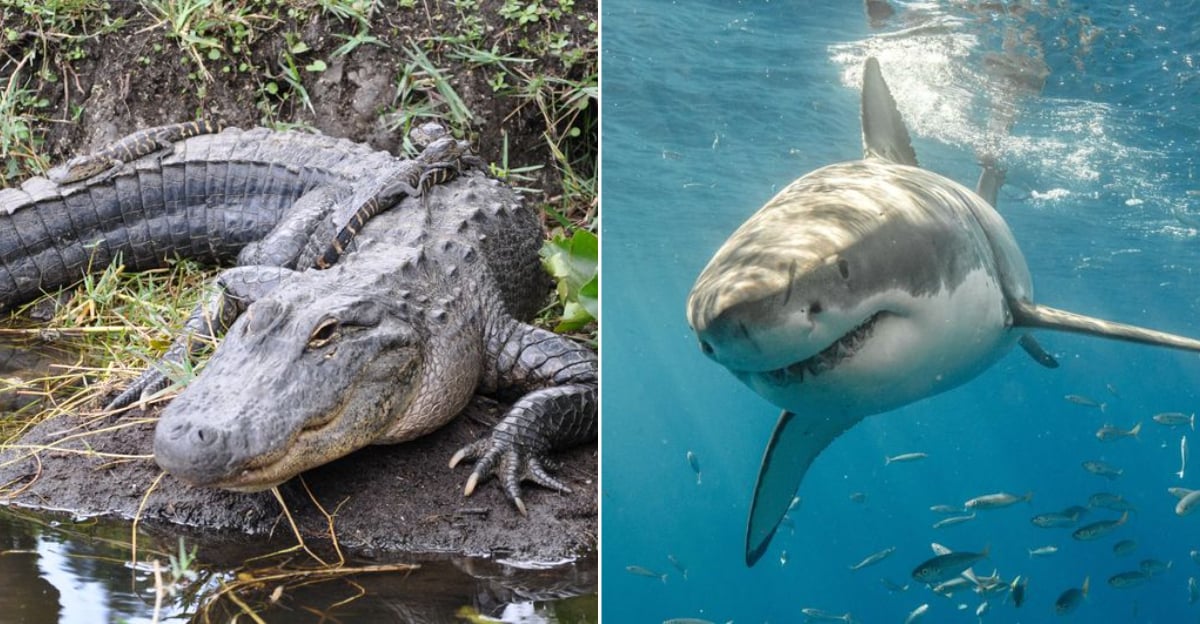Florida’s beauty comes with an edge—sunlit beaches hide stealth predators, swampy trails echo with warning rumbles, and even a simple wildlife wander can turn into a starring role in your own survival story.
From 13-foot crocodiles and airborne stingrays to venomous bugs and invasive snakes, I’ve seen—and felt—the wild side of the Sunshine State.
Ready for the 25 most dangerous animals you might bump into in Florida? Keep reading…and keep your eyes open.
1. Alligator: The Sunshine State’s Iconic Chomper
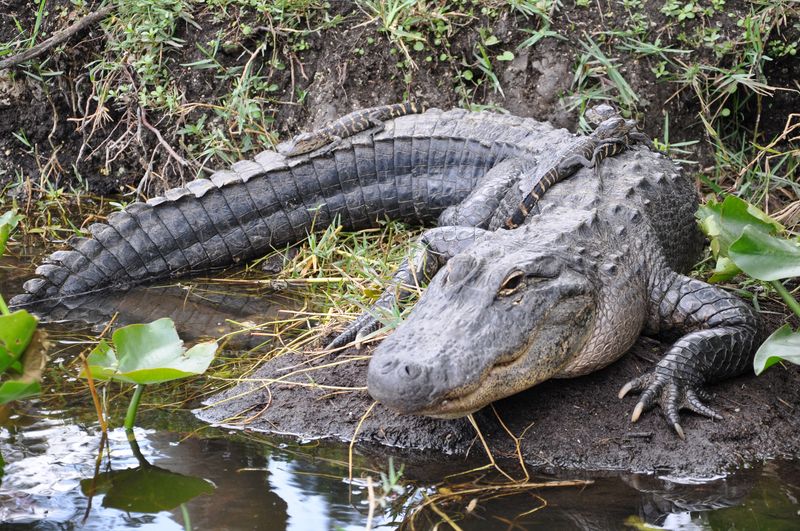
Last summer, I nearly had a heart attack when an alligator’s snout emerged just feet from my kayak in the Everglades! These prehistoric predators are Florida’s most famous dangerous residents, with powerful jaws that can snap with over 2,000 pounds of force.
Adult males typically reach 13-14 feet long and weigh up to 1,000 pounds, making them the largest predators you’ll encounter in Florida’s freshwater systems. They’re surprisingly quick on land too, capable of short bursts up to 30 mph!
While alligators typically avoid humans, they become particularly dangerous during mating season (April-June) or when protecting their young. Never feed them (it’s illegal anyway) and keep pets away from water edges, especially at dawn and dusk when gators are most active.
2. American Crocodile: The Rarer, Toothier Cousin
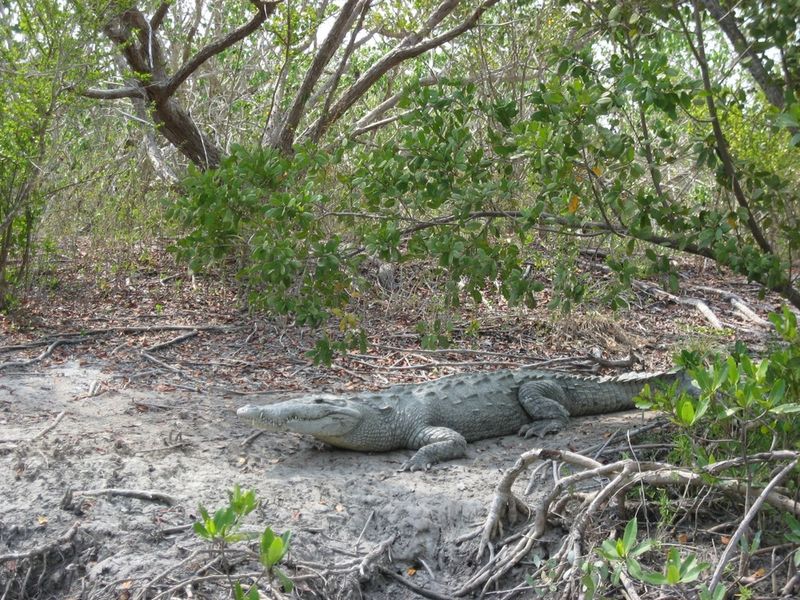
“Those aren’t tears, they’re calculating your odds of escape,” joked my tour guide when we spotted an American crocodile sunning itself in the Florida Keys.
Unlike their more common alligator relatives, these magnificent reptiles sport a narrower snout and visible lower teeth even when their mouth is closed. American crocodiles are actually quite shy around humans, preferring the brackish and saltwater environments of South Florida.
They’re endangered, with only about 2,000 remaining in the wild, but that doesn’t make them any less dangerous if provoked. Growing up to 15 feet long, these powerful predators have a bite force that can crush turtle shells! While attacks on humans are extremely rare, maintaining a respectful distance is always the wisest choice when encountering these prehistoric survivors.
3. Bull Shark: The Freshwater Surprise
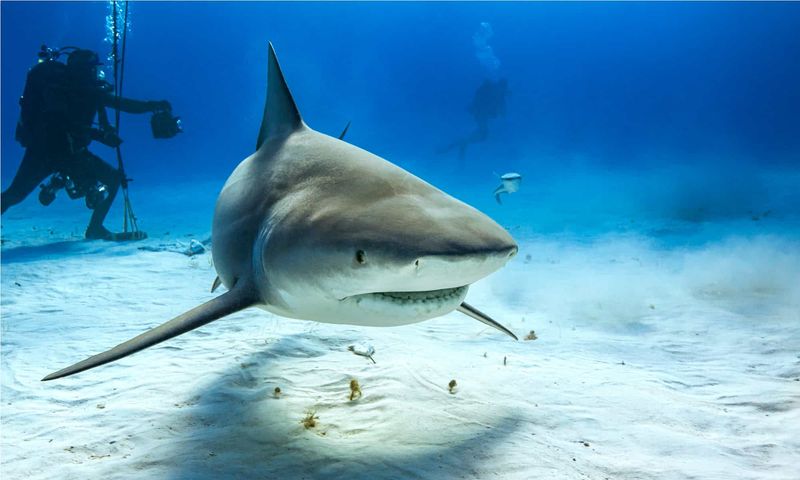
Splashing around in a coastal river near Tampa, I never imagined I was sharing water with one of the ocean’s most aggressive predators! Bull sharks are unique among sharks for their ability to tolerate freshwater, sometimes swimming miles upriver where you’d least expect to encounter them.
These stocky, aggressive sharks are responsible for more attacks on humans than any other shark species. Their powerful bite, territorial nature, and tendency to swim in shallow waters make accidental encounters all too possible.
Growing up to 11 feet long and weighing over 500 pounds, they pack serious muscle behind those multiple rows of teeth. What makes bull sharks particularly dangerous is their unpredictability and tendency to strike first and investigate later. Avoid swimming during dawn or dusk, in murky water, or while wearing shiny jewelry that might resemble fish scales.
4. Great White Shark: The Occasional Visitor
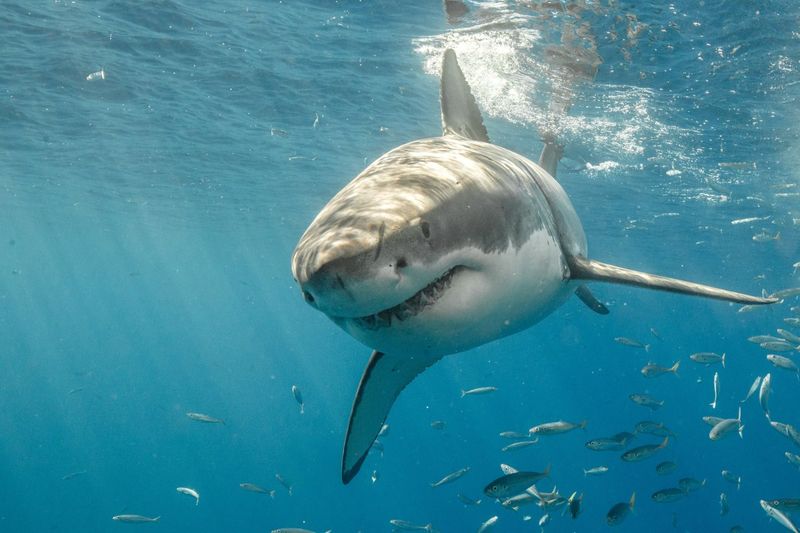
“You’re gonna need a bigger boat” kept ringing in my ears when researchers announced a 15-foot great white named Katherine was pinging off Florida’s coast last winter. Though they prefer cooler waters, these legendary predators do make seasonal appearances along Florida’s coastlines, particularly during winter months. Great whites are the largest predatory fish on Earth, growing up to 20 feet long and weighing over two tons. Their massive jaws contain rows of serrated, triangular teeth perfect for tearing through flesh. Despite their fearsome reputation amplified by movies, attacks on humans are incredibly rare. Scientists believe most great white attacks on humans are cases of mistaken identity – they mistake swimmers or surfers for seals. Still, whenever beach flags indicate shark activity, it’s best to postpone your ocean dip until the coast is clear!
5. Spinner Shark: The Acrobatic Hunter
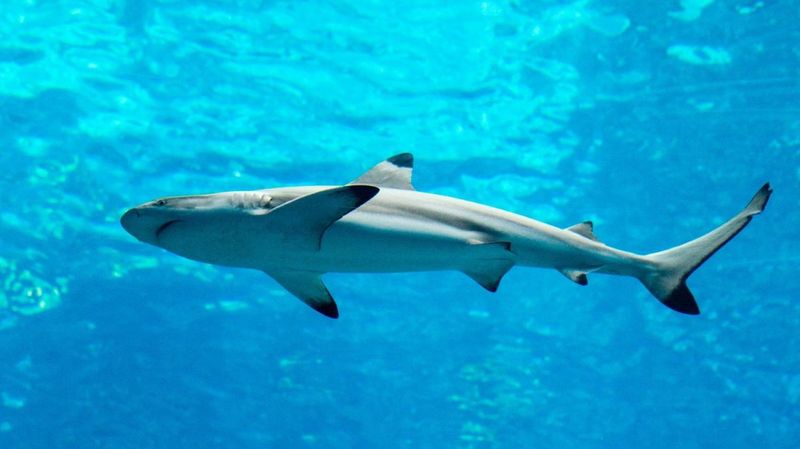
I nearly dropped my binoculars when a spinner shark launched itself six feet into the air, twirling like an Olympic diver before splashing back into the waves off Daytona Beach!
These energetic predators get their name from their unique hunting technique – they spiral through schools of fish, snapping up prey as they spin. Growing up to 10 feet long, spinner sharks are common along Florida’s coastlines, especially during their seasonal migrations.
Their acrobatic feeding displays can bring them startlingly close to shore, sometimes in the same waters where humans are swimming or surfing. While spinner sharks aren’t typically aggressive toward humans, their feeding frenzies can lead to accidental bites if they mistake a limb for prey. Their speed and agility make them particularly unpredictable – if you spot feeding activity or jumping sharks, it’s definitely time to leave the water!
6. Eastern Diamondback Rattlesnake: The Heavyweight Champion
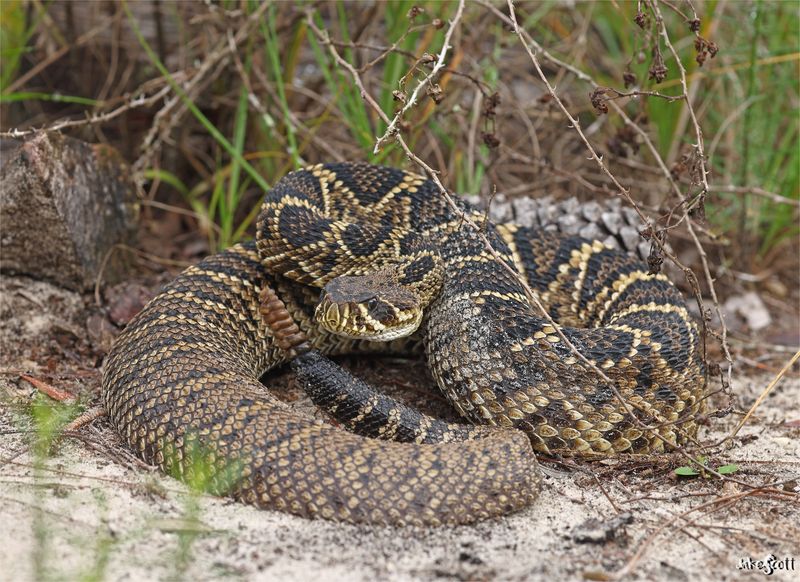
The sudden buzz froze me mid-step while hiking near Ocala National Forest. Coiled beneath a palmetto was the largest dangerous snake in North America – an Eastern diamondback rattlesnake! These formidable reptiles can grow over 7 feet long and weigh up to 10 pounds.
Florida’s heavyweight champion among venomous snakes packs a seriously dangerous punch. Due to their large size, they can inject a significant dose of venom in one bite, which may lead to serious medical complications if not treated in time—including tissue damage and intense internal reactions.
That signature rattle is actually a warning – they’d rather not waste venom on something they can’t eat. When hiking in Florida’s woods or scrublands, stick to clear trails, wear closed shoes, and watch your step. If you hear that distinctive rattle, freeze, locate the snake, and slowly back away – no sudden movements that might trigger a defensive strike!
7. Timber Rattlesnake: The Woodland Ambusher
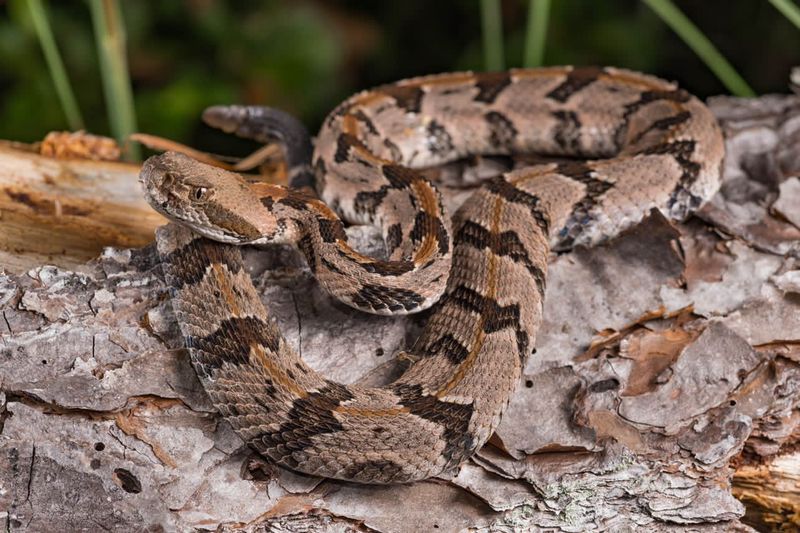
“Freeze!” my hiking buddy whispered urgently as I was about to step over a fallen log in Apalachicola National Forest. Perfectly camouflaged against the forest floor was a timber rattlesnake, its banded body virtually invisible among the leaves and dappled sunlight.
Also known as canebrake rattlesnakes, these venomous pit vipers are masters of disguise, using their patterned bodies to disappear into woodland environments. They typically grow 3-5 feet long and prefer Florida’s northern forests and swampy areas.
Unlike their diamondback cousins, timber rattlesnakes are generally more secretive and less likely to warn before striking. Their hemotoxic venom destroys tissue and prevents blood from clotting – a potentially lethal combination without swift medical attention. When exploring Florida’s forests, always scan the path ahead and never reach blindly into brush, rock piles, or hollow logs where these snakes might be resting.
8. Pygmy Rattlesnake: The Tiny Terror

Don’t let the name fool you – I learned the hard way that the pygmy rattlesnake’s bite packs a serious punch despite its diminutive size! While photographing wildflowers in central Florida, I nearly placed my hand inches from one of these miniature menaces.
Growing only 1-2 feet long, these small but potent rattlesnakes are actually responsible for more bites in Florida than their larger cousins. Their tiny rattle sounds more like an insect buzzing than the classic rattlesnake warning, making them easy to overlook. Their gray bodies with dark blotches blend perfectly with Florida’s sandy soils and grassy areas.
Though rarely fatal to adults, their cytotoxic venom causes intense pain, swelling, and tissue damage requiring medical attention. Their small size means they can hide virtually anywhere – in garden mulch, landscaping, or even potted plants, making them a common unwelcome visitor to Florida backyards.
9. Cottonmouth: The Swamp Defender
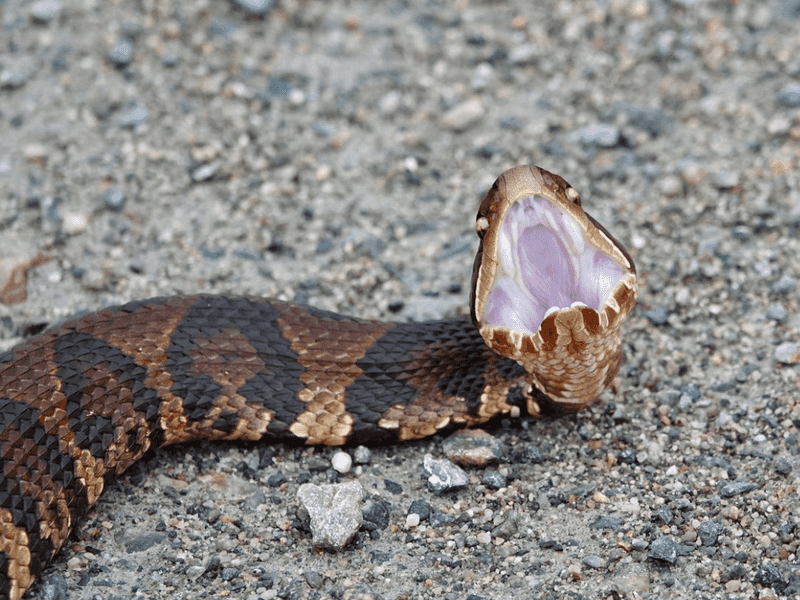
My canoe trip through Fakahatchee Strand took an exciting turn when a cottonmouth dropped from an overhanging branch, landing with a splash just feet away! Also called water moccasins, these semi-aquatic pit vipers are among Florida’s most feared snakes due to their aggressive reputation.
When threatened, cottonmouths display their namesake white mouth lining – a warning display that’s unmistakable once you’ve seen it. They typically grow 2-4 feet long and inhabit virtually any wet habitat in Florida, from marshes and swamps to drainage ditches and pond edges. Unlike many snakes that flee when confronted, cottonmouths often stand their ground.
Their venom contains enzymes that destroy tissue and prevent blood from clotting, making bites extremely painful and potentially dangerous. When exploring Florida’s wetlands, watch where you place your hands and feet, and never attempt to move or handle these territorial snakes – their strike range is greater than you might expect!
10. Copperhead: The Northern Interloper
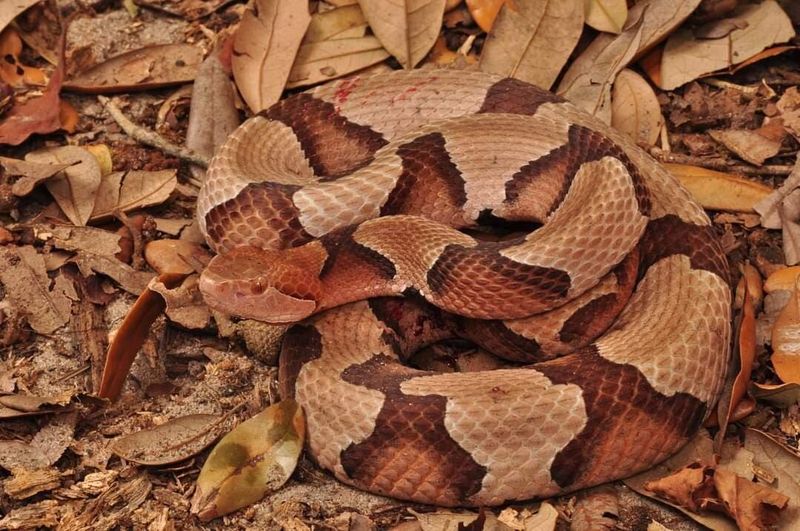
During a family camping trip in Florida’s panhandle, my uncle mistook a copperhead for a harmless water snake – a serious mistake we still laugh about at family gatherings!These beautiful but dangerous snakes are limited to Florida’s northernmost counties, preferring woodland habitats with plenty of cover.
Copperheads earn their name from their distinctive copper-colored heads and hourglass-shaped crossbands. Masters of camouflage, they virtually disappear when lying among fallen leaves. Unlike rattlesnakes, copperheads give no warning before striking, making accidental encounters particularly dangerous.
Though their venom is generally less potent than other pit vipers, copperhead bites are excruciating and can cause permanent tissue damage. They’re responsible for more venomous snakebites in the United States than any other species, largely because their excellent camouflage makes them nearly impossible to spot until you’re right on top of them!
11. Eastern Coral Snake: The Colorful Danger

‘Red touches yellow, be cautious, fellow’—that old rhyme helped me steer clear of danger when I spotted a coral snake while gardening at my Tampa home! With their bold red, yellow, and black bands, these elapids (close relatives of cobras) are among Florida’s most visually striking yet seriously venomous reptiles. Their small size and timid nature often make them easy to overlook.
Coral snakes possess a neurotoxic venom more potent than any other North American snake! Unlike pit vipers that deliver venom through fangs, coral snakes have small, fixed fangs requiring them to chew to inject venom – but that doesn’t make their bite any less dangerous. Their venom attacks the nervous system, potentially causing respiratory failure without prompt medical attention.
Coral snakes are most common in peninsular Florida, hiding in leaf litter, rotting logs, or underground burrows. If you spot those distinctive bands, remember: admire from a distance, and never, ever attempt to handle these vividly dangerous snakes!
12. Florida Panther: The Endangered Predator
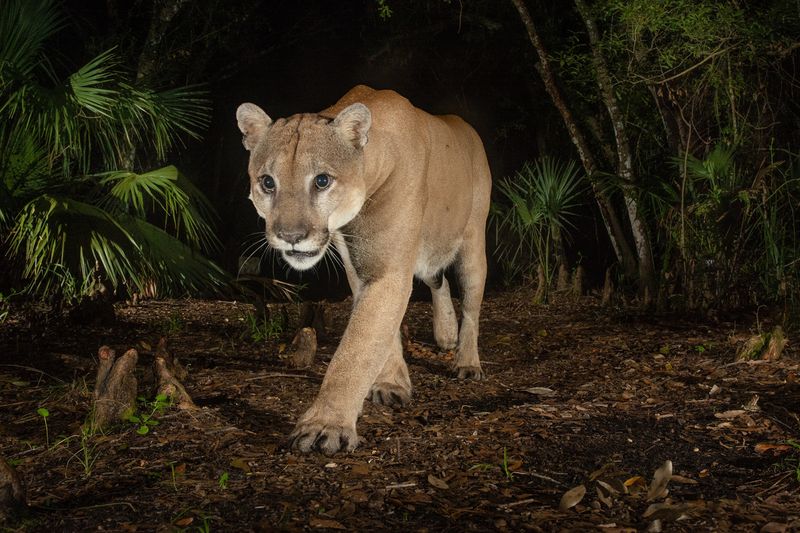
Heart pounding, I watched through binoculars as a Florida panther silently stalked through the underbrush in Big Cypress National Preserve – a rare sighting of America’s most endangered big cat!
With fewer than 230 remaining in the wild, these magnificent predators are phantoms of Florida’s remaining wilderness. Standing about 2 feet tall at the shoulder and stretching 6-7 feet from nose to tail, adult panthers can weigh up to 160 pounds of pure muscle. They’re capable of taking down prey much larger than themselves, including wild hogs and deer.
Their power is matched only by their stealth – many Floridians live their entire lives without ever glimpsing one. While attacks on humans are extremely rare (none documented in Florida’s modern history), panthers should never be approached if encountered. Their territory requirements are enormous, driving them increasingly into areas where humans live and recreate, especially in southwest Florida.
13. Wild Boar: The Tusked Invader
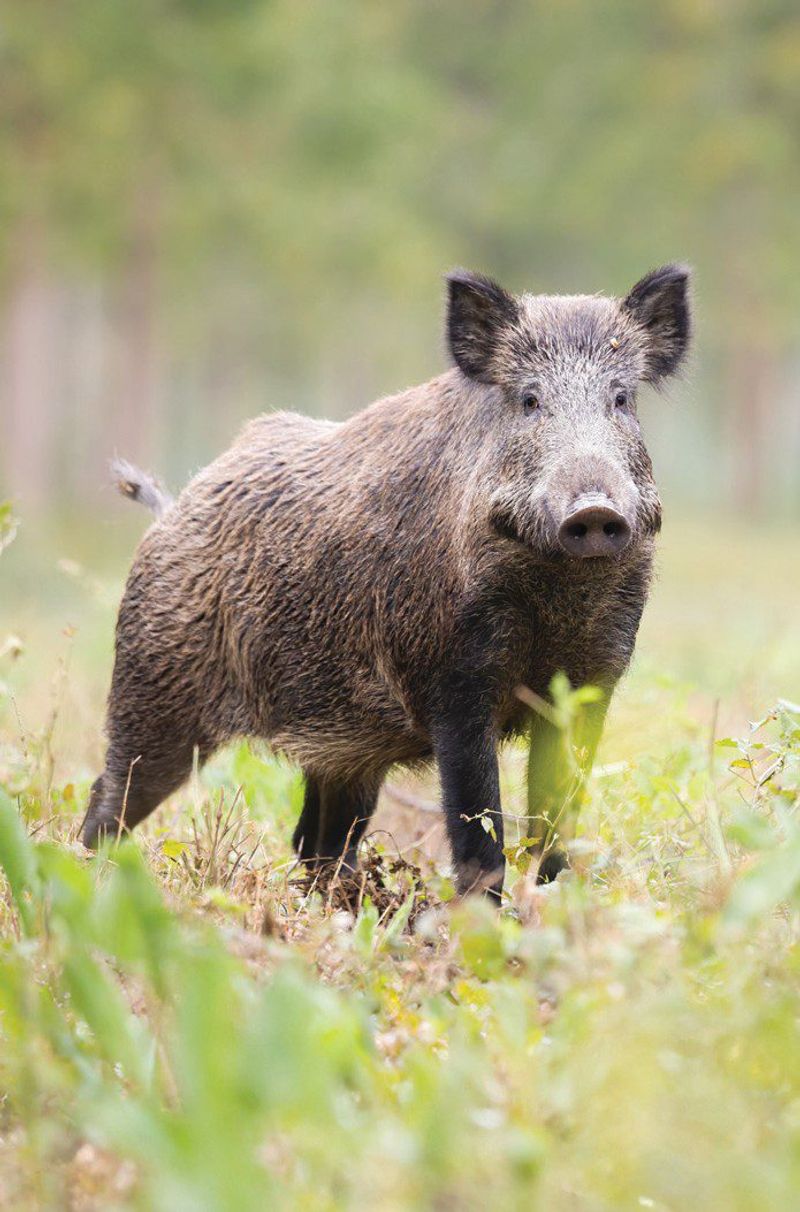
My peaceful morning hike through Myakka River State Park turned into an adrenaline-fueled sprint when I rounded a bend and surprised a sounder of wild boars with piglets! These non-native invaders might look like farm pigs, but they’re anything but domesticated.
Introduced by Spanish explorers in the 1500s, wild boars have thrived throughout Florida, causing extensive environmental damage with their rooting behavior. Adults can weigh over 300 pounds and sport sharp, curved tusks capable of inflicting serious wounds.
Males are particularly dangerous during mating season, while females become extremely aggressive when protecting young. Wild boars possess surprising intelligence and adaptability, allowing them to exploit virtually any habitat in Florida. They’re most active at dawn and dusk, often traveling in groups called sounders. If encountered, your best bet is to slowly back away – never run, as this may trigger a chase response from these surprisingly fast animals!
14. Black Bear: The Forest Giant

Nothing gets your attention quite like finding massive bear tracks along your favorite hiking trail! I discovered this firsthand in Ocala National Forest, home to Florida’s largest land mammal – the black bear. Despite their name, Florida black bears range in color from black to brown and cinnamon.
Males can weigh up to 450 pounds and stand 6 feet tall when on their hind legs. These omnivores have adapted surprisingly well to Florida’s changing landscape, sometimes venturing into suburban areas in search of easy meals from unsecured garbage cans or pet food.
Though generally shy and avoiding human contact, bears can become dangerous if startled, protecting cubs, or habituated to human food. Never approach bears or their cubs, and when camping in bear country, properly store food and garbage. If you encounter a black bear, make yourself look big, make noise, and back away slowly – never run, as this may trigger a chase response!
15. Burmese Python: The Everglades Invader
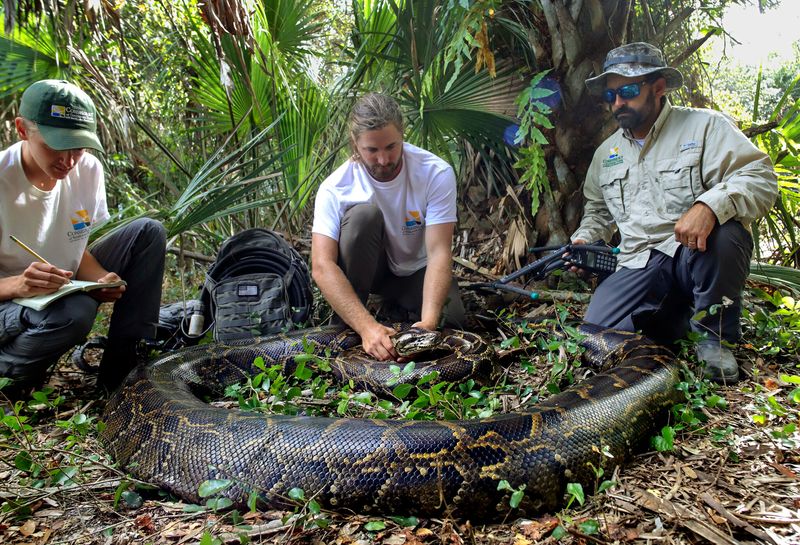
My jaw dropped when park rangers showed me a 16-foot Burmese python they’d captured in Everglades National Park – it was thicker than my thigh! These massive constrictors are one of Florida’s most problematic invasive species, wreaking havoc on native wildlife since irresponsible pet owners released them into the wild.
Growing up to 20 feet long and weighing over 200 pounds, these ambush predators have established breeding populations throughout South Florida. They’re excellent swimmers and climbers, with camouflage patterns that make them nearly invisible in the Everglades’ dappled light. Their incredible strength allows them to overpower prey much larger than themselves.
While python attacks on humans are rare, they’re not unheard of – especially with larger specimens capable of seeing humans as potential prey. Children and pets are particularly vulnerable. If you spot one in the wild, maintain a safe distance and report the sighting to the Florida Fish and Wildlife Conservation Commission.
16. Lionfish: The Beautiful Invader

Snorkeling off the Florida Keys, I was mesmerized by a lionfish’s elegant, feather-like fins – until my guide frantically signaled me to back away from this gorgeous but venomous invader! Native to the Indo-Pacific, these striking fish have become one of Florida’s most problematic marine invaders since appearing in the 1980s. Don’t let their beauty fool you – lionfish pack a painful punch.
Their distinctive fan-like fins contain up to 18 venomous spines that deliver an excruciating sting, causing intense pain, swelling, and sometimes breathing difficulties or paralysis. With no natural predators in Florida waters, they’ve spread rapidly, decimating native fish populations on coral reefs.
While not aggressive toward humans, lionfish don’t flee when approached, increasing the chance of accidental contact with their venomous spines. If stung, immerse the affected area in hot (not scalding) water to help break down the venom, and seek medical attention if symptoms worsen.
17. Box Jellyfish: The Transparent Terror
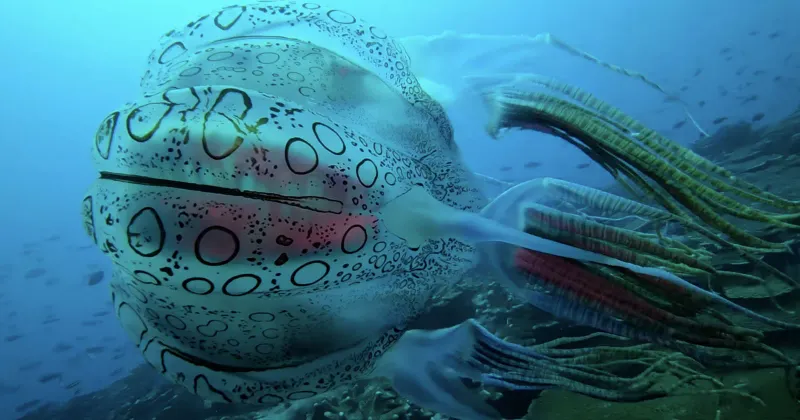
My beach day in the Florida Keys turned terrifying when warning flags went up announcing box jellyfish in the water! These nearly transparent creatures are among the most venomous marine animals on Earth, occasionally drifting into Florida waters, especially in summer and fall months.
Box jellyfish get their name from their cube-shaped bells and can grow up to 10 inches in diameter with tentacles stretching 10 feet long. Each tentacle contains thousands of microscopic stinging cells called nematocysts that inject venom on contact.
The sting is known to cause severe discomfort, often compared to extreme heat and sharp muscle pain. While the species found in Florida waters aren’t as dangerous as their Australian relatives, stings can still lead to strong reactions including difficulty breathing and heart-related symptoms.Their transparent bodies make them nearly impossible to spot in water, so always heed beach warning flags and consider wearing protective clothing when swimming during jellyfish season.
18. Black Widow Spider: The Red-Marked Menace
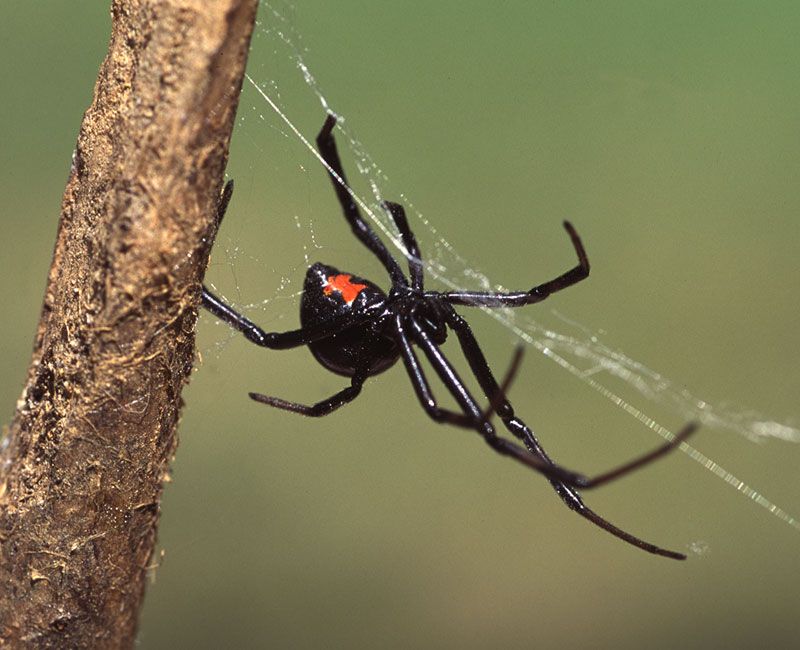
Reaching for a garden pot in my Tampa backyard, I narrowly avoided a close encounter with the glossy black spider sporting the unmistakable red hourglass on its abdomen! Black widows are Florida’s most notorious arachnids, hiding in dark, undisturbed areas around homes and gardens. These shy spiders don’t seek human interaction, but their defensive bites pack a powerful neurotoxin that’s 15 times stronger than rattlesnake venom! Females (the dangerous ones) have shiny black bodies about the size of a dime, with distinctive red hourglass markings on their undersides. They typically build irregular, tangled webs in protected spaces like woodpiles, under eaves, or in garden debris. While rarely fatal to healthy adults, their bites cause intense pain, muscle cramps, and potentially serious systemic symptoms requiring medical attention. When working in the garden or garage, wear gloves and shake out stored items before reaching into dark spaces where these venomous spiders might be lurking.
19. Brown Recluse Spider: The Six-Eyed Stalker
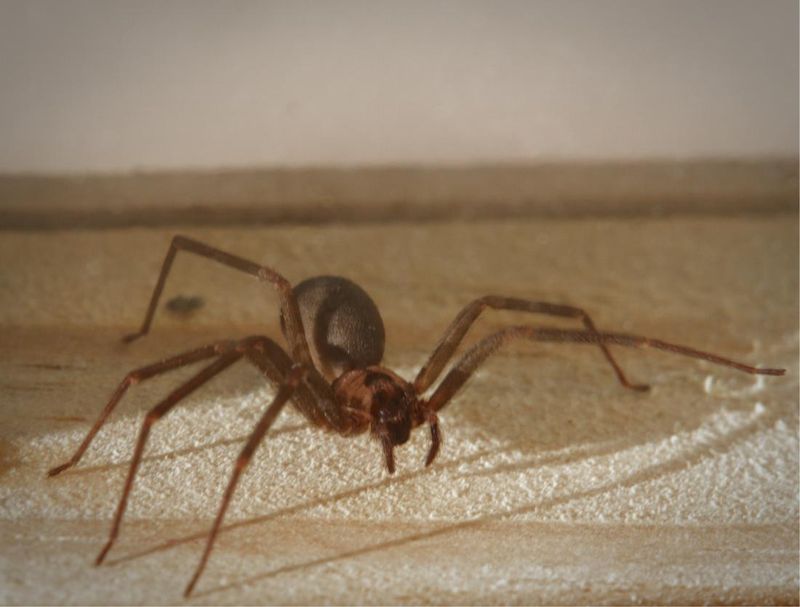
Finding a violin-shaped marking on a spider in my North Florida garage sent me running for identification guides – the telltale sign of a brown recluse! Though less common in Florida than in other southeastern states, these venomous spiders have established populations, particularly in the panhandle region.
Unlike most spiders that have eight eyes, brown recluses have just six arranged in three pairs – though you’d need a magnifying glass to count them! Their light brown bodies feature a distinctive violin or fiddle shape on the back. True to their name, they’re shy creatures, preferring undisturbed areas like closets, attics, and storage boxes.
Their bite initially might go unnoticed, but their venom contains an enzyme that destroys tissue, potentially creating a growing ulcer that’s slow to heal. When sorting through stored items or cleaning rarely-used spaces, wear gloves and long sleeves, and shake out shoes and clothing before wearing them.
20. Fire Ant: The Tiny Threat
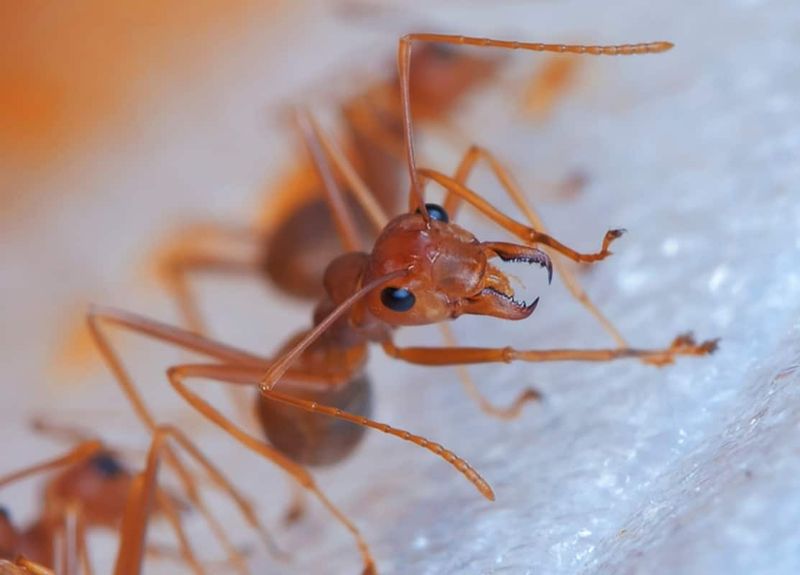
My first Florida picnic became memorable for all the wrong reasons when I sat on a fire ant mound and ended up in the emergency room with severe allergic reaction! These aggressive little invaders have spread throughout the state, creating raised mounds in lawns, parks, and natural areas. Imported fire ants are reddish-brown and tiny (about 1/8-1/4 inch long), but what they lack in size they make up for in numbers and aggression.
When their mound is disturbed, hundreds swarm out, grab onto skin with their jaws, then pivot their bodies to deliver multiple stings in a circular pattern. Each sting injects a venom that causes a burning sensation (hence the name), followed by itchy white pustules that can last for weeks.
For the estimated 1% of the population with severe allergies, these stings can trigger life-threatening anaphylaxis. Always watch where you step or sit in grassy areas, and consider treating your yard if fire ant mounds appear.
21. Scorpion: The Nocturnal Hunter

Flipping over a piece of bark while collecting firewood near Tallahassee, I came face-to-face with a Florida bark scorpion, its stinger raised in warning! While Florida’s scorpions aren’t as dangerous as their desert cousins, their painful stings can still ruin your day.
Three species call Florida home, with the Florida bark scorpion being most common. These nocturnal arachnids grow 2-3 inches long, with tan or brown bodies and specialized pincers for grabbing prey. During daylight hours, they hide under logs, rocks, or loose tree bark, emerging at night to hunt insects and spiders. Their stings typically cause intense localized pain, swelling, and numbness that may last several days.
For most healthy adults, Florida scorpion stings aren’t medically serious, but they can cause stronger reactions in children or those with allergies. When camping or working outdoors, always shake out shoes and sleeping bags, and wear gloves when gathering firewood or moving natural debris.
22. Raccoon: The Rabies Risk
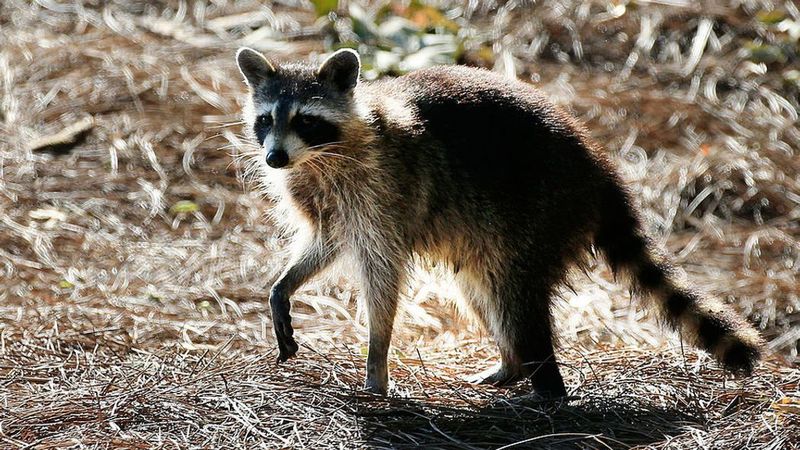
Those adorable masked bandits raiding my Orlando campsite weren’t just cute nuisances – they’re actually one of Florida’s most common carriers of rabies! Raccoons thrive throughout the state, adapting brilliantly to urban, suburban, and wilderness environments alike.
Despite their charming appearance – with distinctive black masks and ringed tails – raccoons can be surprisingly aggressive, especially if cornered or infected with rabies. Their sharp claws and teeth inflict painful wounds, but the real danger comes from the diseases they carry. Beyond rabies, they can transmit roundworm, leptospirosis, and other pathogens through bites or contact with their waste.
Raccoons showing unusual behavior – such as staggering, seeming overly friendly, being active during daylight, or showing excessive drooling – may be rabid and should be reported to animal control immediately. Never feed wild raccoons, secure trash cans with animal-proof lids, and keep pets’ vaccinations current to prevent transmission of diseases.
23. Houndfish: The Ocean Javelin
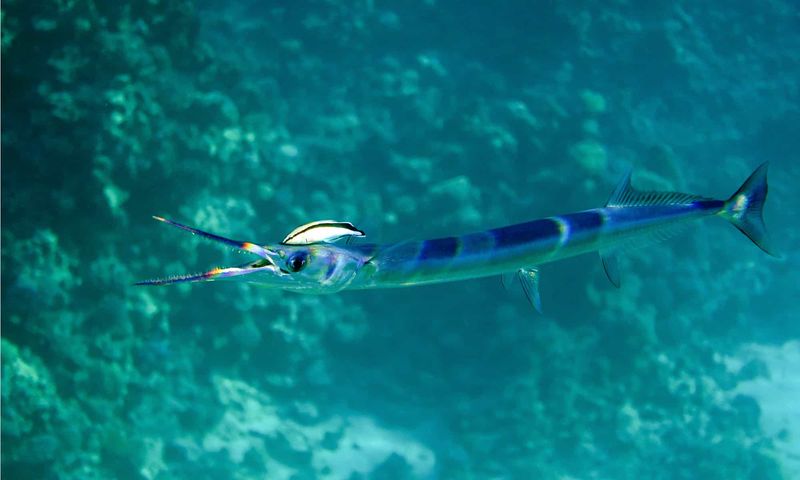
My fishing buddy still has the scar from when a houndfish launched itself from the water like a missile, nearly impaling him during our trip off Key West! These slender, needle-like fish are essentially living javelins, capable of leaping from the water at high speeds.
Growing up to 5 feet long but only a few inches thick, houndfish (also called crocodile needlefish) sport elongated jaws filled with sharp teeth. Their sleek, silver bodies and bluish-green backs make them difficult to spot in Florida’s coastal waters. They’re typically found in shallow, clear waters around seagrass beds, reefs, and mangroves. What makes them dangerous isn’t aggression but their peculiar habit of leaping from the water when startled, particularly at night when attracted to boat lights.
Their rigid bodies and pointed jaws have caused serious injuries and even fatalities when they’ve speared unsuspecting boaters or waders. When fishing in areas known for houndfish, consider wearing protective gear and staying alert for jumping fish.
24. Skunk Ape: The Swamp Sasquatch
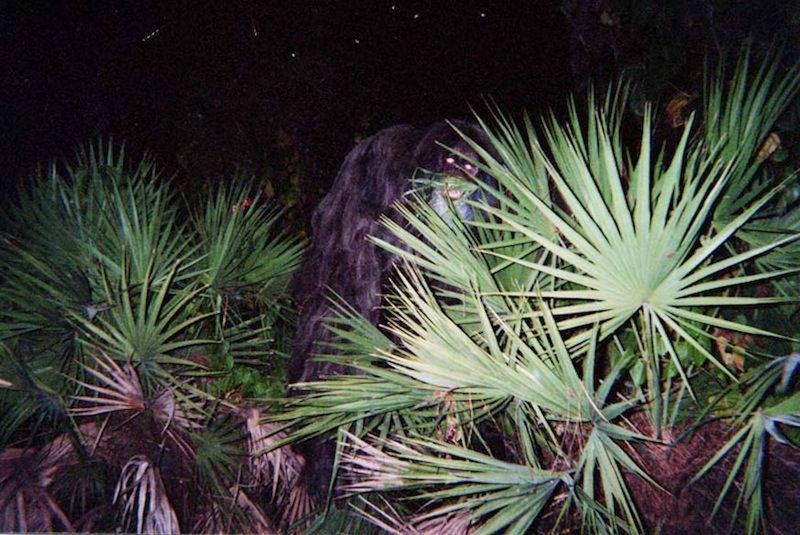
Camping deep in the Everglades, I’ll never forget the bone-chilling howl that echoed through the cypress trees at midnight – could it have been Florida’s legendary skunk ape? Part folklore, part cryptozoological mystery, this elusive creature is Florida’s answer to Bigfoot. Described by alleged witnesses as a 7-foot tall, ape-like biped covered in reddish-brown hair with a distinctive foul odor (hence the name), the skunk ape supposedly inhabits Florida’s most remote swamps and wilderness areas.
Reports date back decades, with occasional blurry photographs or footprint casts offered as evidence of its existence. While most scientists dismiss the skunk ape as myth or misidentification of known animals like bears, true believers insist these creatures are real and potentially dangerous if cornered.
Whether real or imagined, the legend adds a delicious element of mystery to Florida’s wild places. If you’re exploring the deep swamps, perhaps keep your camera ready – you might make cryptozoological history!
25. Portuguese Man-Of-War: The Floating Colony
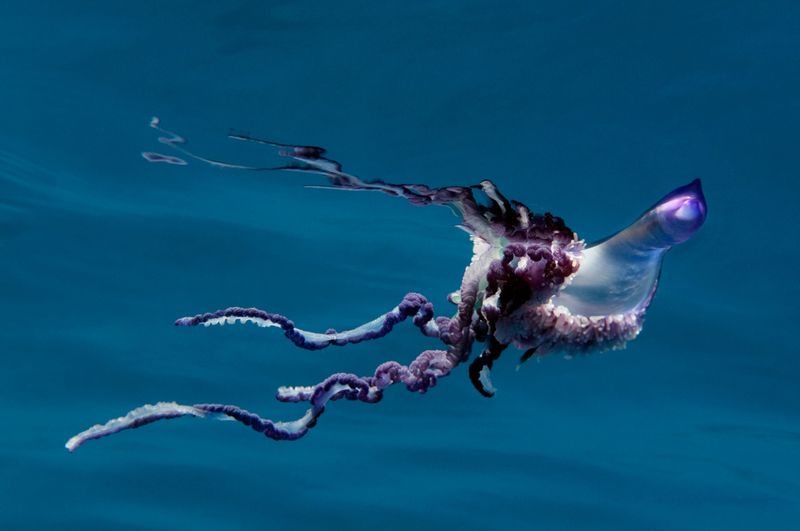
Walking along Daytona Beach after a storm, I spotted what looked like blue balloons washed ashore – Portuguese man-of-wars that had left dozens of swimmers with excruciating stings the previous day! Despite resembling jellyfish, these fascinating creatures are actually colonial organisms composed of specialized individual animals working together.
Their distinctive blue or purple gas-filled float (up to 12 inches long) keeps them on the surface while trailing venomous tentacles that can extend 30-100 feet below. Their tentacles are lined with thousands of stinging cells that can remain active even after the organism has washed ashore. These creatures are commonly brought to Florida’s Atlantic beaches by wind and currents, particularly in the cooler months.
Contact with those beautiful but dangerous tentacles causes immediate, intense pain, welts, and blistering that can last for days. In severe cases, stings can cause fever, shock, and respiratory distress. If stung, remove tentacles with a stick or credit card (never bare hands!), rinse with seawater (not fresh water), and seek medical attention for severe reactions.
